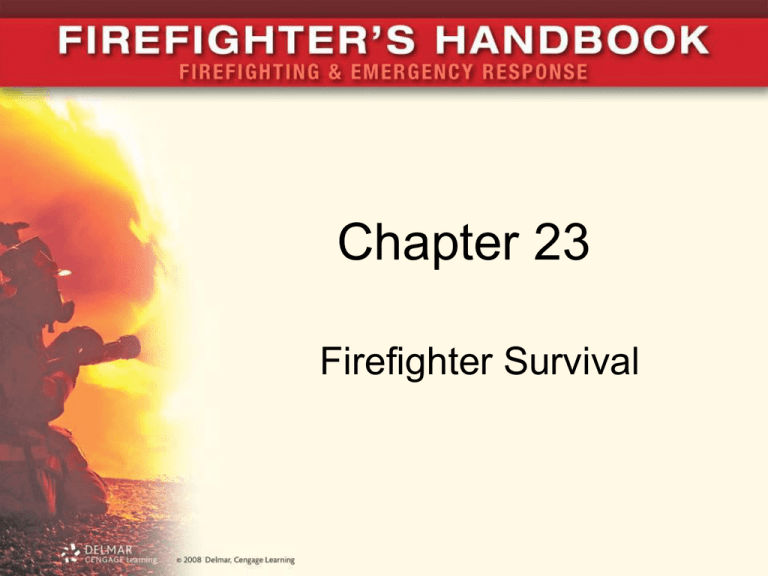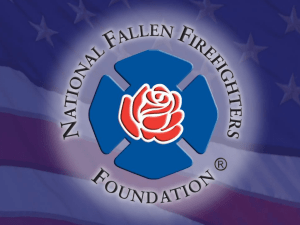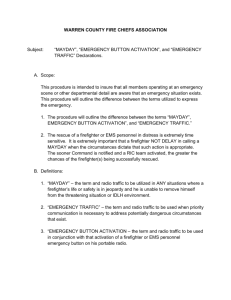Chapter 23
advertisement

Chapter 23 Firefighter Survival Introduction • Survival dependent on: – Prevention through readiness – Training on firefighter emergency procedures • Factors that help prevent emergencies: – PPE; task accountability; fitness for duty – At an incident: deliberate actions (or inaction); attention to hazards – Attention to team continuity, orders, communication, rapid intervention planning, rehabilitation • Must have a planned systematic process for self-rescue or rapid intervention in emergencies 23.2 Incident Readiness • Incident readiness is a mental process that answers a few questions: – – – – – Am I in a position to respond? Is my personal protective equipment available? What is my relationship to the response? Physically can I respond? Mentally, can I check out my current thoughts and focus on response? • Ensure the “system” is assembled and ready for response 23.3 Personal Protective Equipment • PPE is the first thing to put on for protection – Last thing to use for protection • In many departments, firefighters check all ensembles at beginning of every shift • Time spent donning gear before arriving at incident is well spent – If seatbelts cannot be worn, better to don PPE at incident • Following an incident, gear may need to be decontaminated 23.4 Preparing PPE for Readiness • All clothing materials are dry. • All PPE is present and positioned so that it may be donned rapidly. • Essential pocket tools are available and in working order. • Alternative PPE items are appropriately packed and ready for use. • Additionally, firefighters should check protective equipment assigned to their riding position 23.5 Personal Accountability • Three types of accountability: – Passport – Tag – Company officer • No freelancing • Relationship to response: assignments and personal size-ups • Perform as trained • Know your strengths and weaknesses 23.6 Figure 23-2 Accountability systems take on many forms—firefighters must know how to check in. 23.7 Figure 23-3 Firefighters achieve mastery of tasks through repeated training. Mastery reduces the chance of injury. 23.8 Fitness for Duty • Mental fitness – “Check out” of the environment, “check in” to size-up • Physical fitness and wellness – – – – – – Cardiovascular conditioning Core strengthening Flexibility improvement Resistance training Nutritional balance Hydration maintenance 23.9 Energy and Rest • Safety directly affected by energy potential and rest a firefighter has stored • Be attentive to energy and rest levels • Communicate rehabilitation needs to an officer 23.10 Safety at Incidents • Roughly half of all duty-related injuries and deaths happen at incident scene • Individual injured failed to “see” events that lead to injury • Injuries and death occur when firefighters allow urgency to override judgment • Firefighters can prevent injury and death through mental and physical actions • Team continuity – Team must exercise guarded judgment when completing a task 23.11 Figure 23-6 Team continuity reduces the chance for injuries. 23.12 Team Procedures for Incidents • Utilize an incident command system (ICS) • Work together and remain intact • Look after each other • Prevent freelancing 23.13 Figure 23-5 Freelancing is eliminated and incident success is gained when specific tasks are assigned to teams of two or more firefighters operating from a single incident action plan. 23.14 Orders/Communication • Incident commander responsible for assembling incident action plan (IAP) – Implemented by teams performing tasks – Tasks assigned to organized teams in the form of orders – Team responsible for carrying out the order • Providing updates on a regular basis • Relay information about hazards • First arriving teams perform prescribed tasks – They must know tasks, tools required, and safety considerations 23.15 Figure 23-8 Practicing good reporting habits enhances communications. 23.16 Risk/Benefit • Risk/benefit: an evaluation of the potential benefit of a task in relationship to hazards • Basic guidelines: – Take significant risk to save a known life – Take calculated risk, and provide additional safety, to save valuable property or reduce potential for injuries – Take no risk to save what is already lost – Retreat to defensive position when conditions are deteriorating quickly 23.17 Figure 23-9 Solid risk/benefit analysis means taking no risk for that which is already lost. (Courtesy of Richard W. Davis) 23.18 Personal Size-Up • Size-up: continuous situational awareness and mental evaluation process • Stay aware of: – – – – – Established work areas Hazardous energy Smoke conditions Escape routes Air management 23.19 Rehabilitation • Stress and overexertion are leading causes of injury and death – Key concern is controlling heat stress • Rest achieved during crew rotation – Sit down; allow medical personnel to do vital sign check; mentally disengage from the event • Active cooling reduces core body temperature • Water vital to peak operation of body systems • Best nutrition: 30/30/40 balance 23.20 Figure 23-11 Rehabilitation should start well before a firefighter is thirsty or tired. Failure to rehabilitate “early and often” opens the door to injury. 23.21 Rapid Intervention Teams • Rapid intervention team (RIT) rescues firefighters in an emergency – Goal is to avoid need for rapid intervention • Two-in/two-out rule provides for immediate intervention if needed • RIT should have no other assignment – Consists of well-trained, experienced firefighters • Other firefighters should not abandon previous assignments until reassigned 23.22 Table 23-1 RIT Responsibilities Checklist 23.23 Firefighter Emergencies • When emergency presented, firefighter must rely on instincts and training • Study procedures for rapid escape – For declaring a Mayday for lost and trapped situations • Survival includes processes for rescue of trapped and lost firefighters – Also long-term mental survival 23.24 Declaring a Mayday • Specific procedures for declaring any mayday developed at local fire department level • Declaring a mayday: – Transmit over radio “Mayday” three times followed by ICS assignment – Wait for an acknowledgement – Once acknowledgement made, report nature of mayday, current location or last known location – Manually activate PASS device 23.25 Rapid Escape • Evacuation signals: repeated air horn blasts; special radio tone followed by evacuation order • Rapid escape steps: – – – – – Preplan the escape Immediately report need for rapid evacuation Acknowledge rapid evacuation or escape signals Rapidly escape Report successful escape 23.26 Figure 23-12 Rapid fire spread and partial collapse are likely to trigger the need for rapid escape. 23.27 Figure 23-13 A PAR is a personnel accountability report organized to check the status of all crews working an incident. PARs should take place every half-hour or after an evacuation or any firefighter emergency. 23.28 Lost, Trapped, and Injured Firefighters • When firefighting, crews may be placed in environments they have never been in before – Potential to be trapped or lost during assignment • Low-air situations: – Good SCBA air management provides margin of safety • Enter, work, and egress before warning device activates – Low-air warning while in IDLH environment warrants immediate communication 23.29 Lost, Trapped, and Injured Firefighters (cont’d.) • Entrapment: – First step is to get assistance – Activate PASS device and declare “Mayday” – Follow up with other noise-making activities • Be careful not to use up excess energy – Size up and develop a plan – Attempt self-extrication • Planned and systematic 23.30 Lost, Trapped, and Injured Firefighters (cont’d.) • Lost/disoriented firefighters: – – – – – Firefighter or team must report that they are lost Mayday should be transmitted over the radio Manually activate PASS devices Take deep breaths and calm down Take inventory of surroundings • Establish direction, door and window locations, potential paths – Maintain radio contact with RIT members 23.31 Lost, Trapped, and Injured Firefighters (cont’d.) • Injured firefighters: – Firefighters must trust RITs – RIT activated when firefighter found to be trapped or injured – If team in proximity aides firefighter, communicate this – Firefighters not on the RIT or in the vicinity should resist the urge to rush in and help 23.32 Figure 23-14 A serious firefighter injury or fatality will cause significant incident stress. Focus and use of RITs will minimize unnecessary risk during firefighter rescue and help maintain incident control. 23.33 Post-Incident Survival • Post-incident thought patterns: firefighter’s mind relaxes as adrenaline fades – Responsible for many injuries and deaths • Critical incident stress (CIS): incidents that lead to long-term mental and health issues 23.34 Post-Incident Survival (cont’d.) • Post-incident thought patterns – Inattentiveness as soon as order given to “pick up” – Take a time-out and have everyone gather for incident summary and safety reminder – Fatigue and mental drain unavoidable chemical imbalance – Important to stay alert and pick up signs of potential injury • Take steps to “survive” without injury 23.35 Post-Incident Survival (cont’d.) • Critical incident stress – Firefighters expected to tolerate incident stress – Some events trigger significant emotional response • May not always be external • Many firefighters harbor the reaction internally – CIS exhibited in many ways – “Survive” CIS by critical incident stress management (CISM) • Critical incident stress debriefing (CISD) • “Defusing” in a peer environment 23.36 Figure 23-16 Signs of critical incident stress are natural following “trigger” incidents. 23.37 (A) (B) Figure 23-17 Critical incident stress management sessions can be (A) informal such as a “defusing” or (B) formal such as a process that includes peer support and mental health professionals. 23.38 Lessons Learned • Firefighter survival dependent on: – Incident readiness and safe operations – Appropriate preparation and response to emergencies • Safe operations dependent on team continuity • Emergencies require firefighter to practice clear and concise approach • Survive long term through understanding of post-incident thought patterns and stress 23.39








